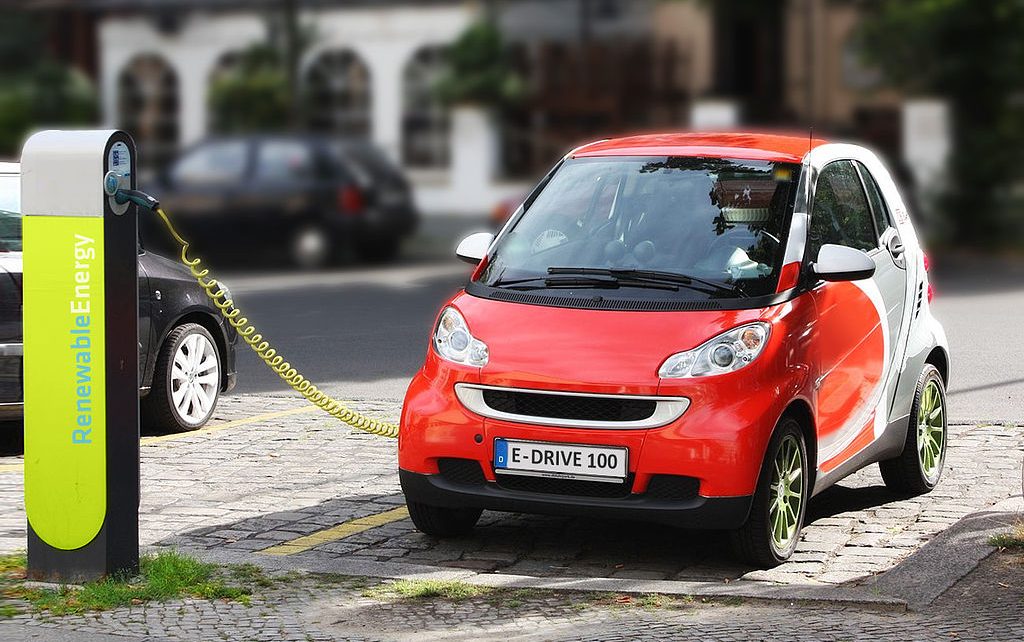
Electric vehicle charging. (Photo: Wikipedia)
‘We’re Coming to a Point of Reckoning’ With CA Utility Bills Skyrocketing
What happens to the electricity grid and tiered pricing when Gov. Newsom’s mandate of all-electric cars becomes reality by 2035?
By Katy Grimes, March 8, 2021 11:33 am
Last week the Globe met with energy expert Jesus Arredondo and discussed the recent California Public Utilities Commission meeting that centered around themes and concepts raised in the CPUC White Paper, Utility Costs and Affordability of the Grid of the Future – California electric and gas cost and rate trends over the next decade.
“The white paper warns that the burden of continually rising utility bills will likely derail California’s decarbonization work if left unaddressed,” Arredondo said. “Worse, the rising costs are hitting customers who’ve been hit hard by pandemic-driven job losses and sheltering at home the hardest.”
California’s “decarbonization work” is the state’s and CPUC’s flawed scheme to reducing greenhouse gas emissions through moving to an all-electric grid, away from oil and gas, coal, hydroelectric and nuclear power.
We discussed the tiered energy pricing now prevalent in California, which penalizes residential ratepayers for household electricity used after 4:00pm, when Californians get home from work and cook dinner, do laundry, wash dishes, bathe children, do homework on computers, and watch television.
Even summer “peak” rates appear to be about 40% – 200% higher, judging from the billing statements.
But Arredondo asked rhetorically, what happens to the electricity grid and tiered pricing when Gov. Gavin Newsom’s mandate of all-electric cars becomes reality by 2035?
It will likely be a lot worse if the current course is maintained.
Arredondo explained that the daily optimum solar energy generation time is 10:00am to 4:00pm. But the sun goes down right when most people get home from work and would plug the electric cars in. Besides the all-electric car goal sounding preposterous, the huge load on the grid after 4:00pm would be devastating.
In 2018, the approximate total number of automobiles registered in California was 15.1 million. Imagine adding even half — 7.5 million electric cars – to the electricity grid, which is already strained. “We are trading energy independence for dependence on Cobalt,” Arredondo said. “We don’t have trees that produce Cobalt,” he added.
Most of the world’s cobalt is mined in the Democratic Republic of Congo. Cobalt is used in every lithium-ion rechargeable battery on earth. Our iPhones, iPads, laptops and electric vehicles all use lithium-ion batteries. According to the Cobalt Institute, the lithium-ion battery is the most commonly used type of battery with cobalt being found in the cathode.
Environmentalists don’t talk about the poor Congolese children used as slave labor to mine Cobalt. Why would politicians prioritize electric cars, and indirectly, the slavery of Congolese children, when we have energy independence in the United States? No children are enslaved and used in the U.S. to mine for coal, or to extract oil and gas, or generate power at hydroelectric dams, or at nuclear power plants.
The continuing unsound decision-making to remove traditional power sources in California is what is behind the ever-increasing utility rates, among other silly notions from the good-idea fairies.
Last week the Globe reported 3.3 million Californians have unpaid utility bills totaling $1.25 billion due to “COVID pandemic impacts.” Those “COVID pandemic impacts” are Gov. Newsom’s ordered business closures and job losses, leading to the inability to pay utility bills.
Arredondo said the Energy Institute at the UC Berkeley Haas School of Business and non-profit think tank Next 10 issued a new report, Designing Electricity Rates for An Equitable Energy Transition, which reveals that the State’s three largest investor-owned utilities (IOUs) charge residential electricity customers much higher prices than are paid in most of the country—prices that are two to three times higher than the actual cost to produce and distribute the electricity provided.
“These high prices result from uncommonly large fixed costs that are bundled into kilowatt-hour prices and passed on to customers,” Arredondo explained. “These costs cover much of the generation, transmission and distribution fixed costs, as well as energy efficiency programs, subsidies for houses with rooftop solar and low-income customers, and increasing wildfire mitigation costs.”
“The report also points to compounding concerns over the high costs, particularly what the report calls the ‘inequity of their distribution.’ Specifically, the report says that as wealthier households transition to rooftop solar, the fixed costs are distributed through a smaller volume of kilowatt-hours delivered, raising the costs even more for remaining, lower-income customers.”
The Cal/Next 10 report advocates for an overhaul of how utilities bill customers for energy usage. The report urges that utilities’ usage rates need to be lowered to reflect the true cost of generating and transmitting electricity, as California has the fourth-highest residential electricity prices in the country. Then, utilities’ fixed rates need to be increased, but they should also be tied to income, so higher earners pay more – as part of their concern with “equity.”
“This would be a sharp change from the current scheme, which the authors argue is regressive because it requires lower-income people to spend a higher proportion of their paychecks on electricity,” Arredondo explained.
As for programs that benefit certain customers at the expense of others — like net metering for rooftop solar owners and bill assistance for lower earners — the report’s authors wrote that those initiatives and other utility “public purpose” programs should be part of the state budget as upfront costs, rather than as ongoing expenses in electric rates.
Arredondo told of a press interview report co-author UC Berkeley Professor Severin Borenstein did with Politico, where he warned, “The path of least resistance is just to keep raising electricity rates, but there’s increasing recognition that’s just not going to work. We’re coming to a point of reckoning here, and I hope the Legislature and the CPUC are going to step up and say we really need to reimagine the way we pay for electricity.”
- Crazies in Climateland Vote to Increase CA Gas Prices by 65¢ per gallon - November 9, 2024
- California Begins its Latest War Against Donald Trump - November 7, 2024
- Gov. Gavin Newsom’s First Threatening Message to President-Elect Trump - November 7, 2024




The 1st thing I know will happen when government pushes for and raises minimum wage is this! And “this”” is just one of so much more.
Great report. Okay, so, skyrocketing utility costs from bad decisions and high “fixed costs” are affecting, or threaten to affect, pet “decarbonization” plans, as well as low-income and COVID-caused subsidization plans, and therefore the whole green future of rainbows and fuzzy bunnies may not happen without someone making some hard decisions? Did I get that right? (I may not have.)
I wanted to add, using my own town as an example, customers are just plain overcharged for utilities in addition to the higher so-called “fixed costs” discussed above. The proof of this is that Water & Power always shows a surplus, which surplus is then transferred into the city’s general fund. It is not applied to reducing utility costs or returned to the customer. So think of the surplus as a “hidden tax.” Some years ago the city residents then (stupidly) voted for a Utility Users’ Tax. Thus we pay a tax on a tax. And the higher the entire utility bill is, the more tax the customer pays and the city receives. The city is thus incentivized to charge whatever it can get away with for utilities, the more the better, because every additional charge discussed in the article above and added here means more tax revenue for the city. I wonder how this figures into the mess. I don’t think my city is alone in this —- I think most CA municipalities are doing it.
California is a rich state, and I suspect the forces of national security are at play. The fact is post-fossil fuel is post petrodollar. Environmentalism has nothing to do with it. I really see an analogy to the German Second Reich incentivizing the invention of synthetic nitrates before the first world war – here, we see a coordinated national security effort to incentivize the development and commercialization of “alternative energy.” The problem is much of the necessity is built on P/R and lies – and this creates blowback. I don’t see why the goverment can’t just tell the truth.
Deplorables
Gas has gone up at least 60 cents a gallon, propane gone to the moon, electricity follows….up up and away….everything is too expensive…..many young and dumb still spending toward infinity and soon to be sucked plucked by the “Black Swan”. Inflation baby….is cruel, very uncaring and cleans you slowly and completely out, so you cannot afford even brown bags to take your Valveeta on Wonder bread to your Globalist service job with no benefits, no future, no nothing….
p.s. the recall ain’t gonna help ya
The solution becomes clearer by the day…
Why is it that Utopian ideals turn into Dystopian nightmares!
I am waiting for Mad Max to coming roaring down my street in his futuristic hot rod that runs on recycled cooking oil and solar panels.
Or maybe a flying unicorn can take us all to la la land! Oh wait, do unicorns have flatulence?
How does one stop carbon dioxide from naturally occuring?
Wake Up Californians. Zero carbon emissions is an unachievable myth.
As Katy, so perfectly stated:
“The continuing unsound decision-making to remove traditional power sources in California is what is behind the ever-increasing utility rates, among other silly notions from the good-idea fairies.”
It really is that simple.
No kidding, Cali Girl. Well put.
Oh, gotta go, Mad Max is at the door. 🙂
The global warmers use Lenin’s principle, “a lie repeated often enough becomes the truth.”
When we don’t push back on the global warmers’ big lie, freedom and prosperity inevitably lose.
The state song should be revised to “Venezuela here I come”.
HA! Really.